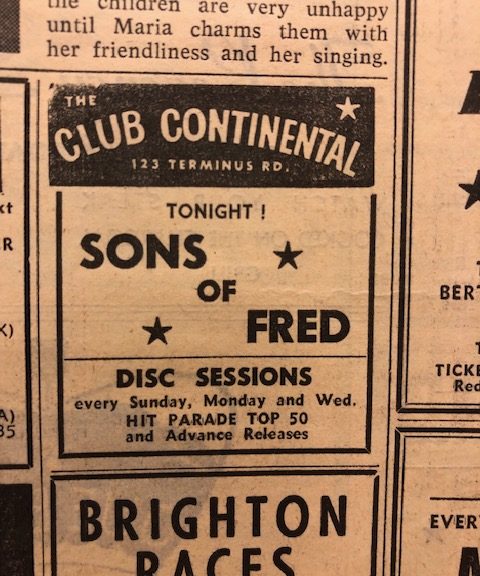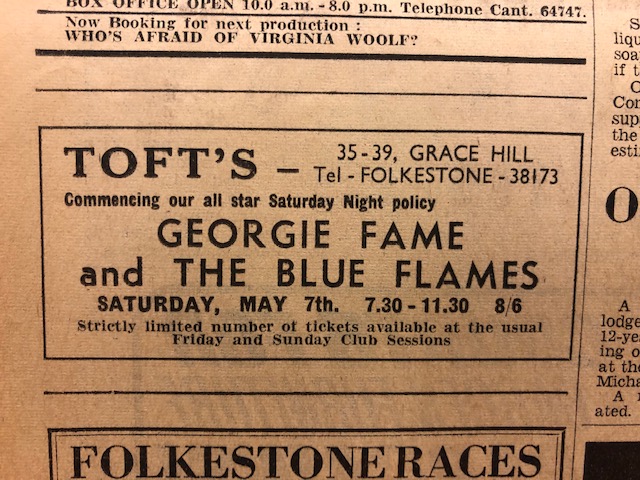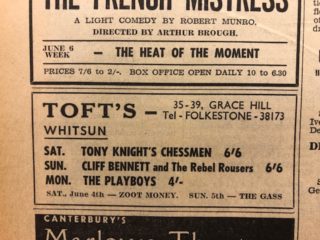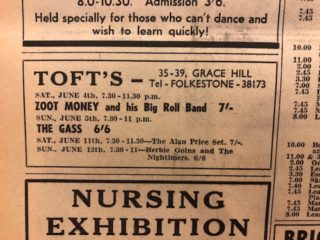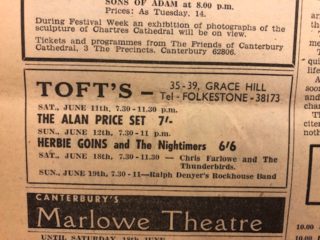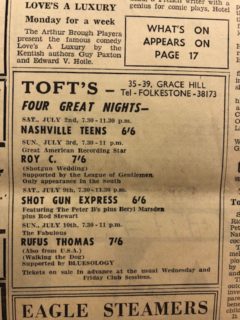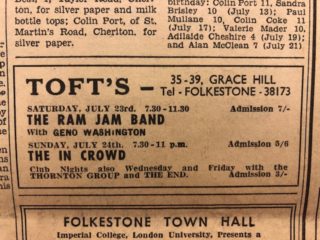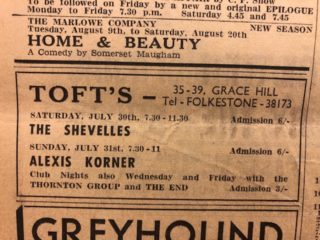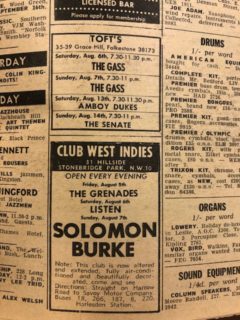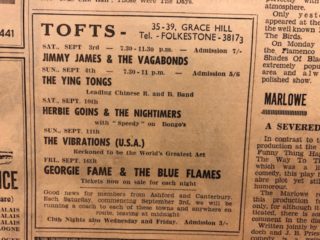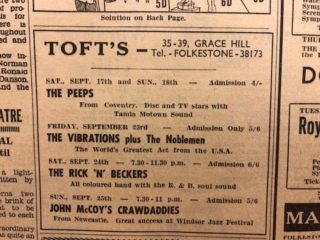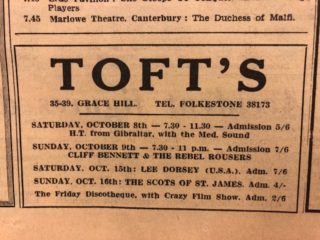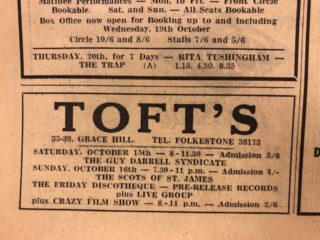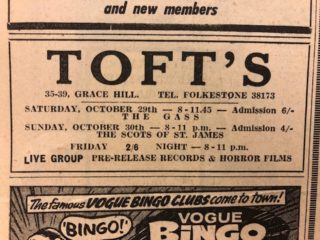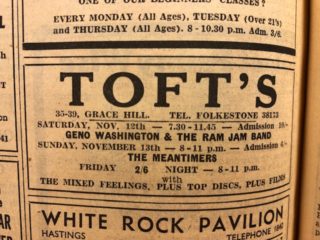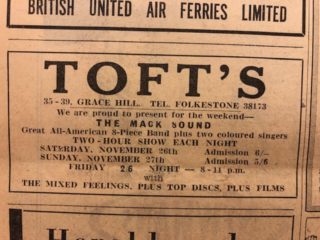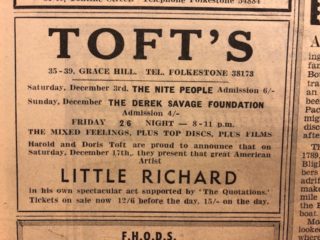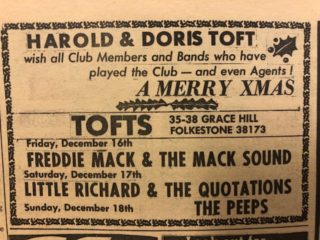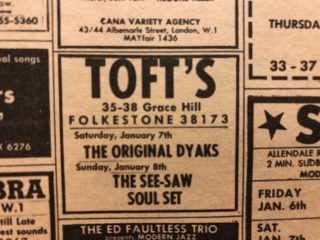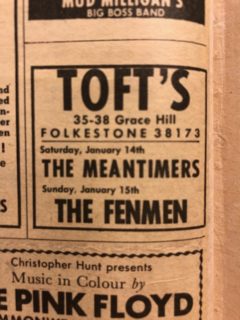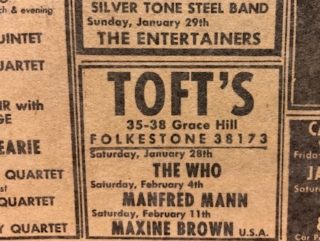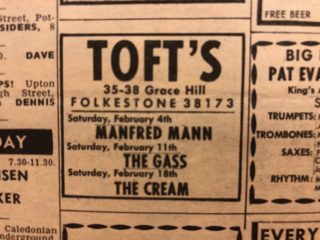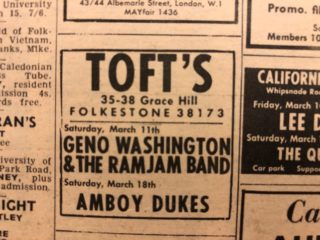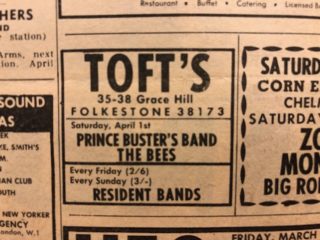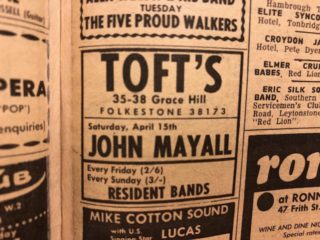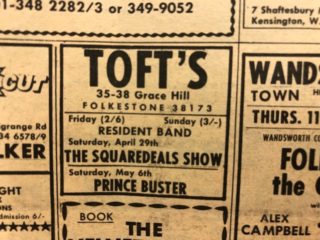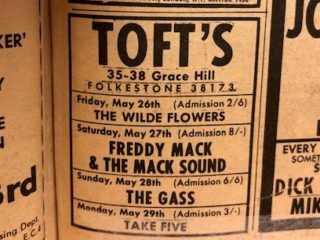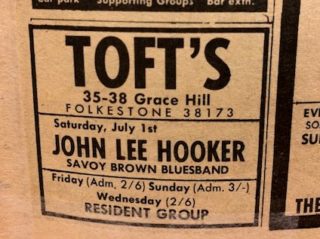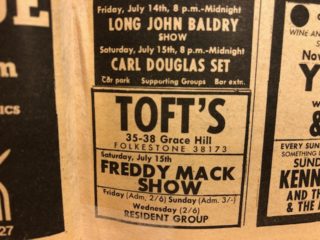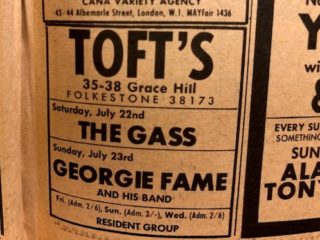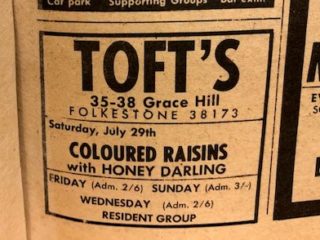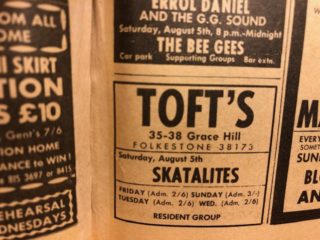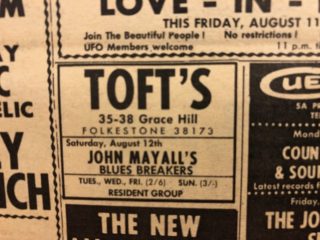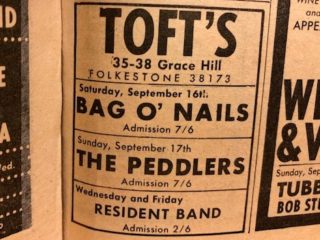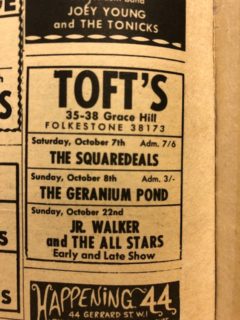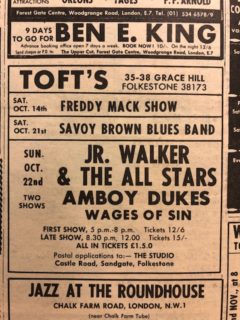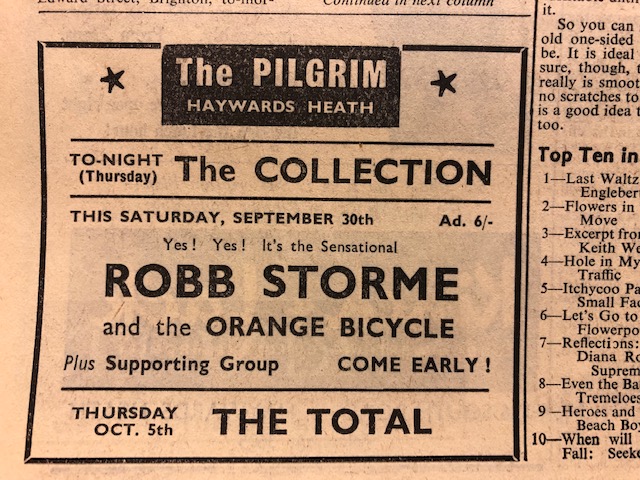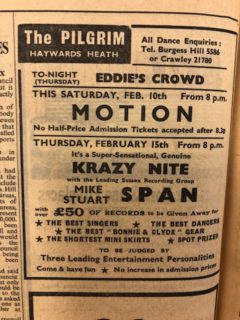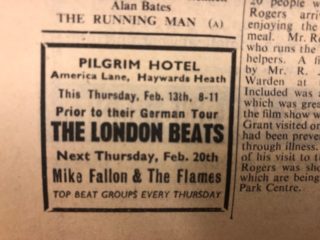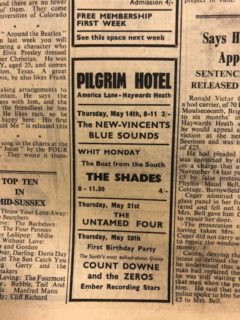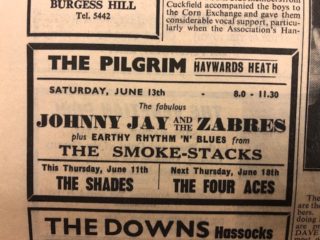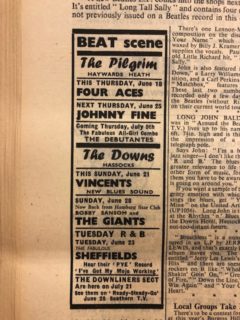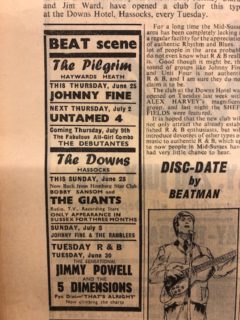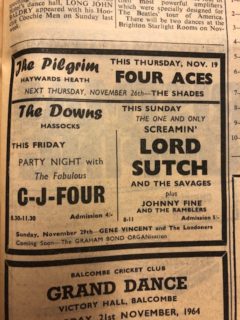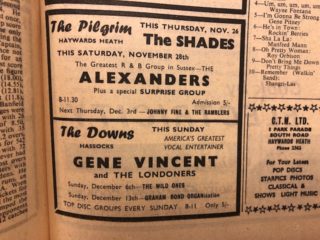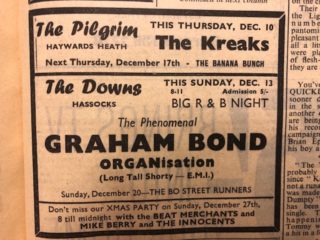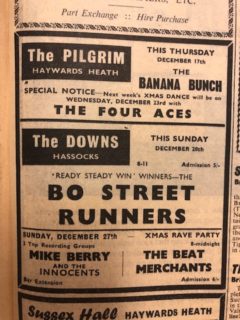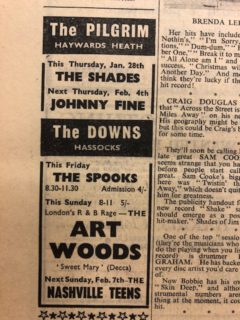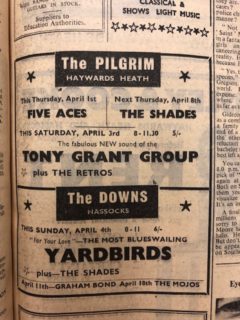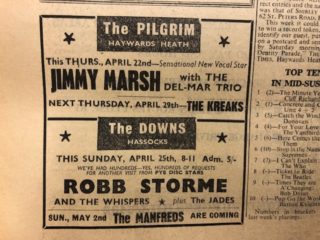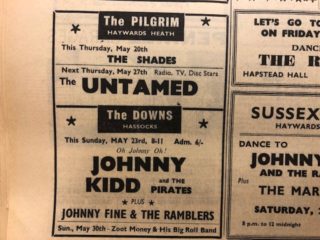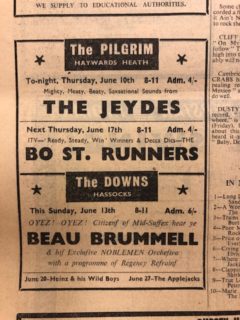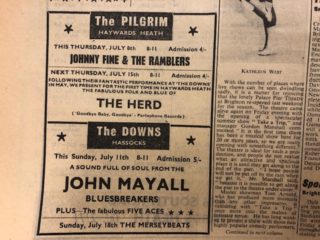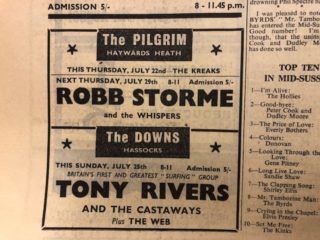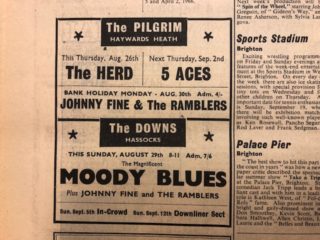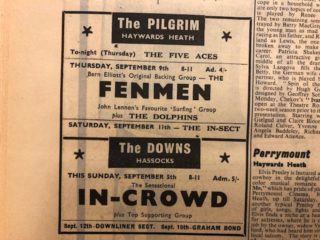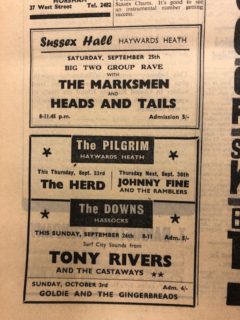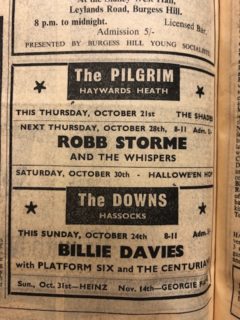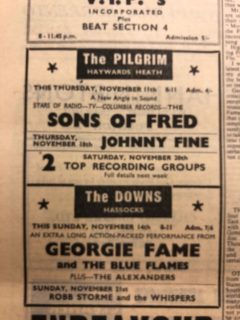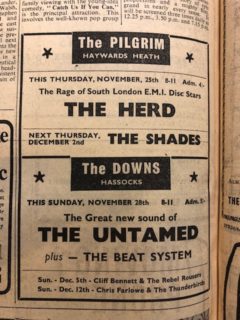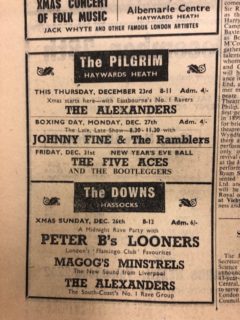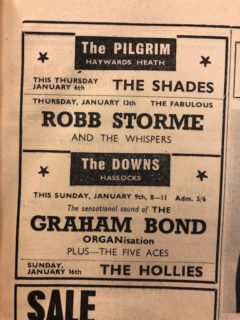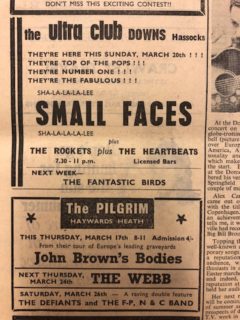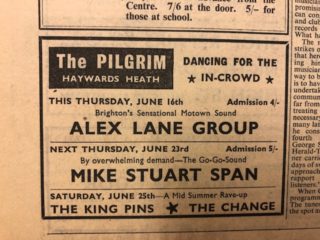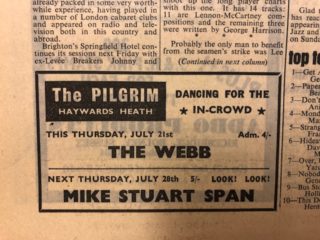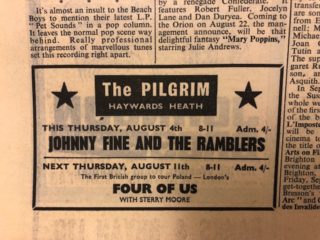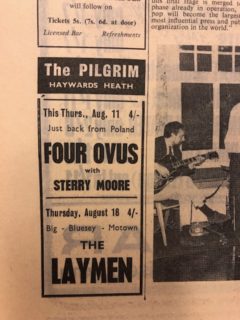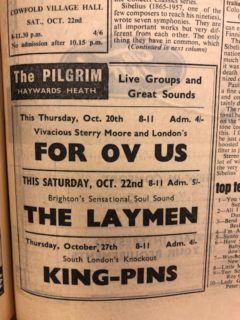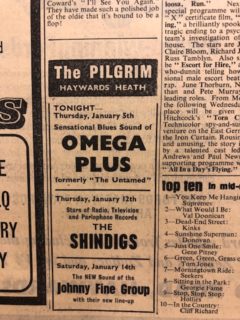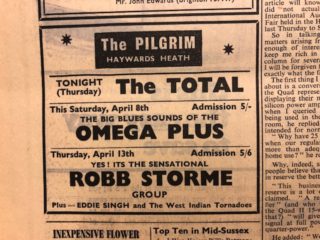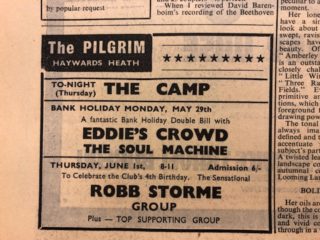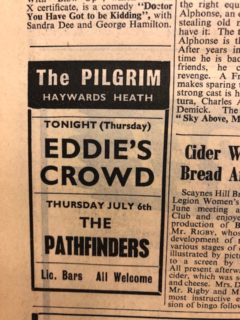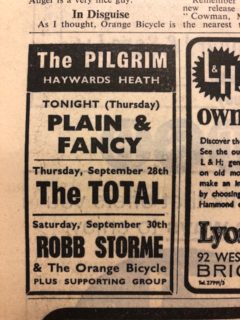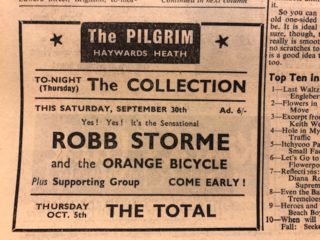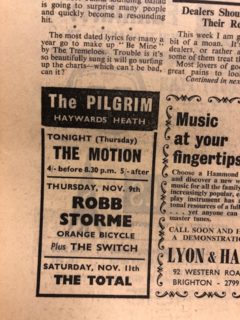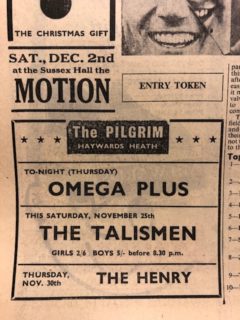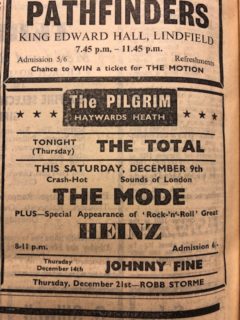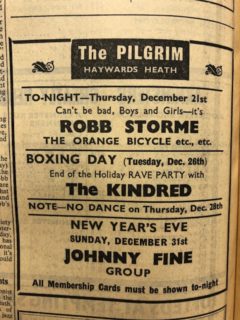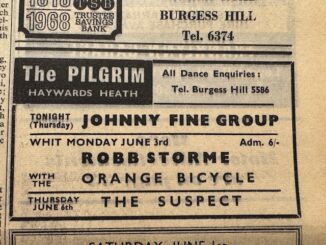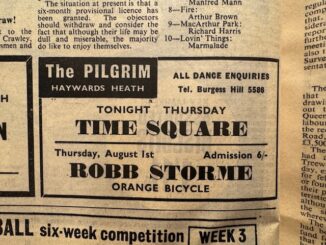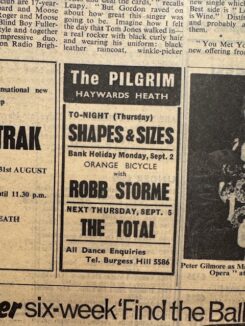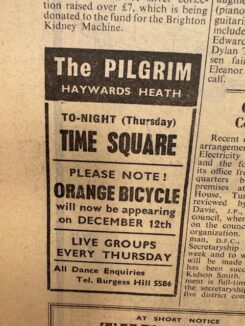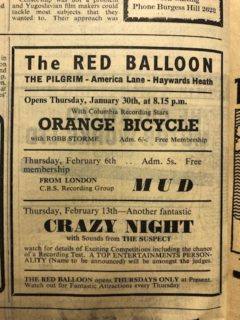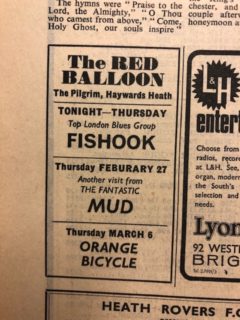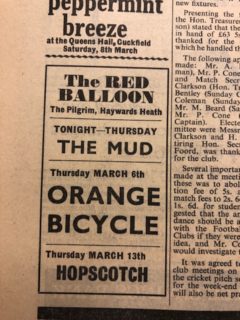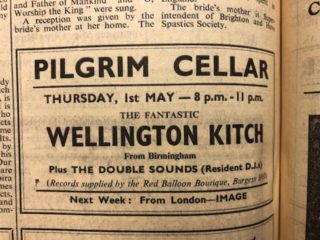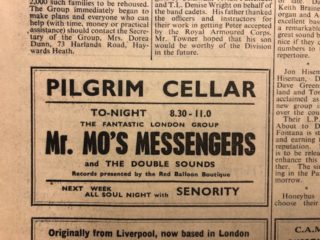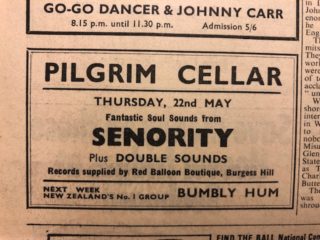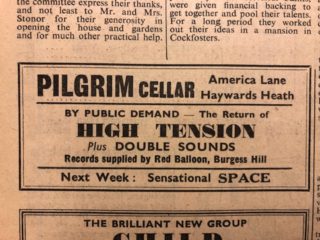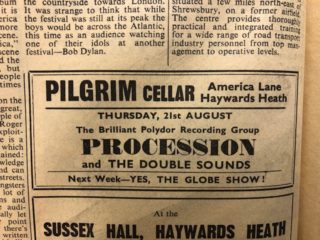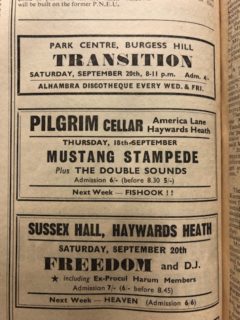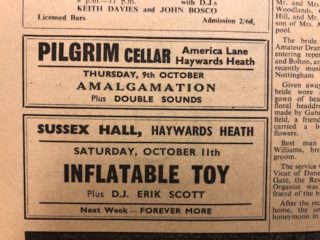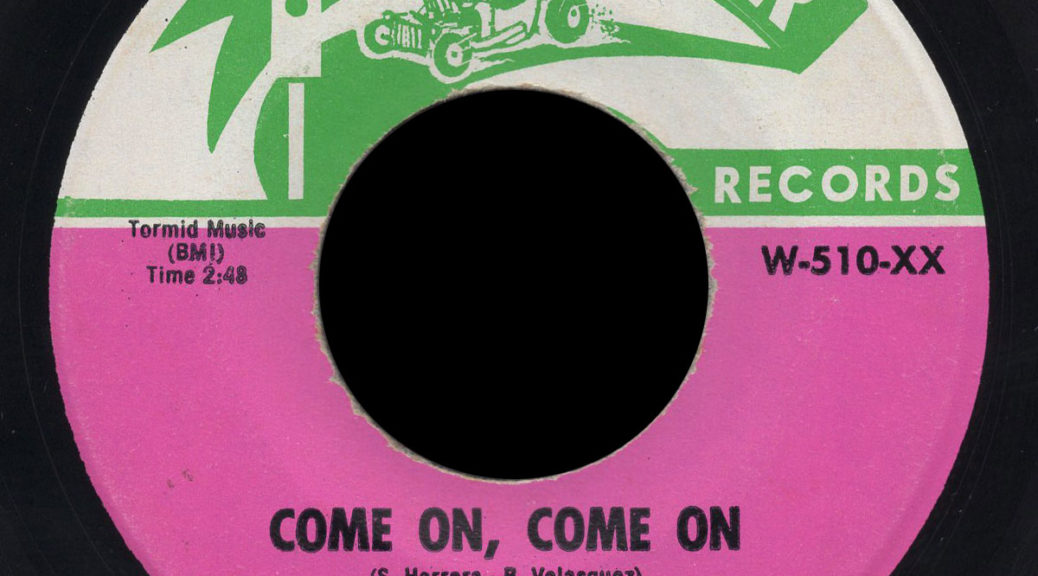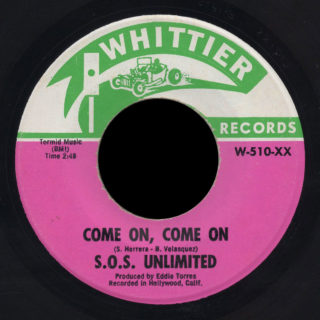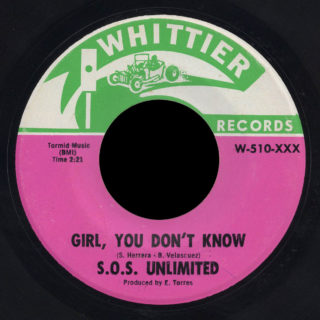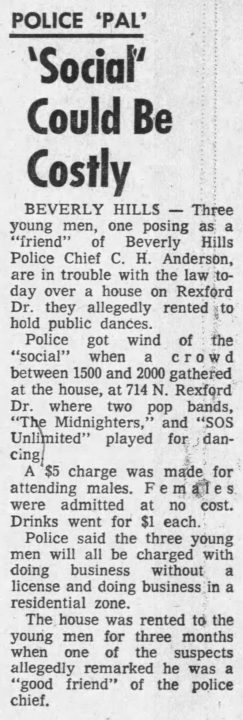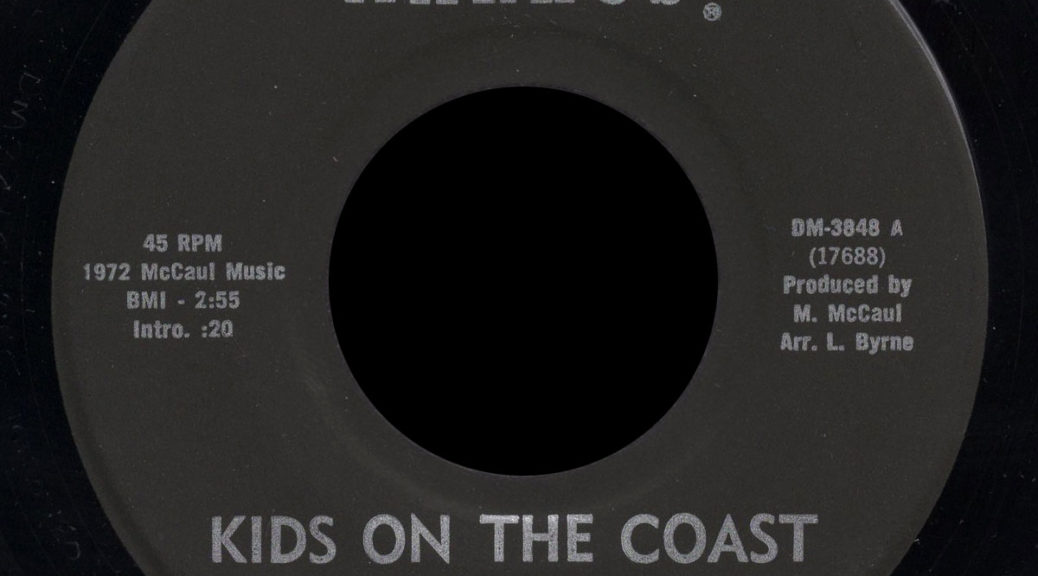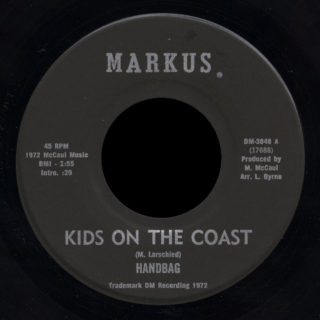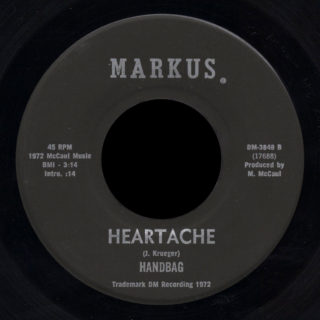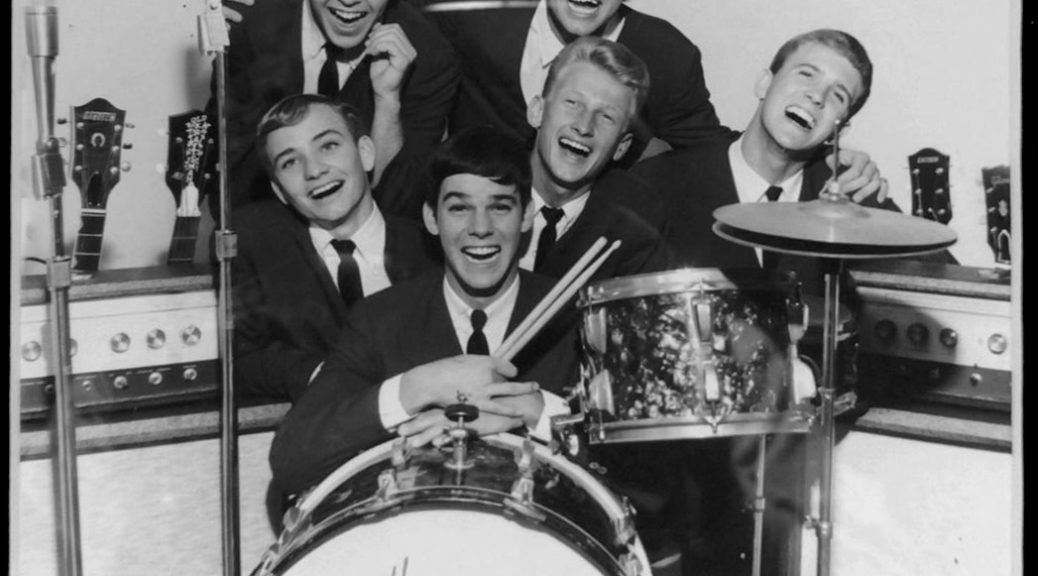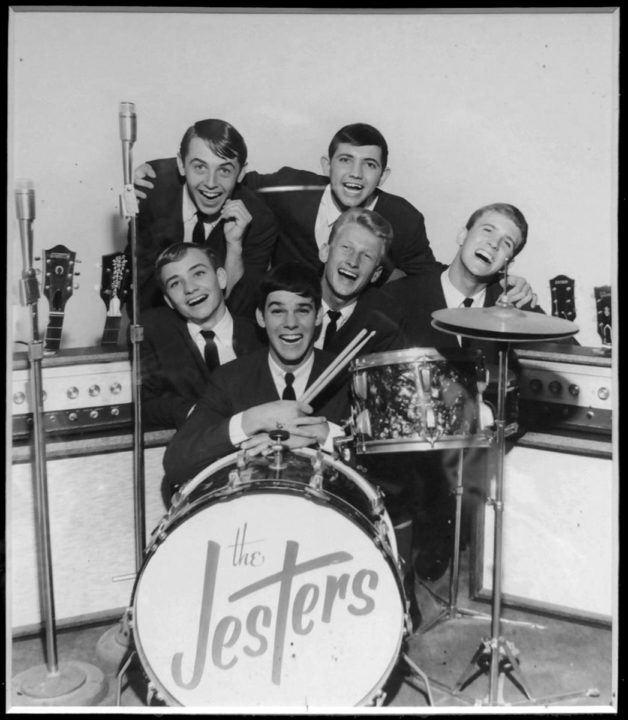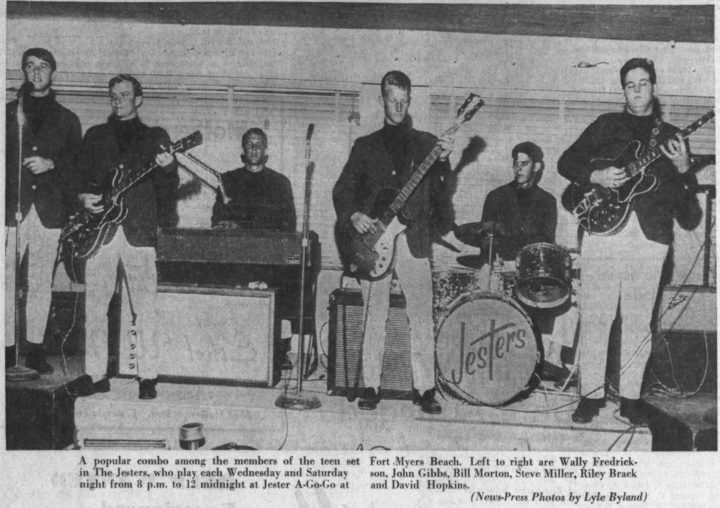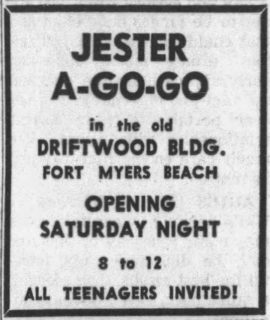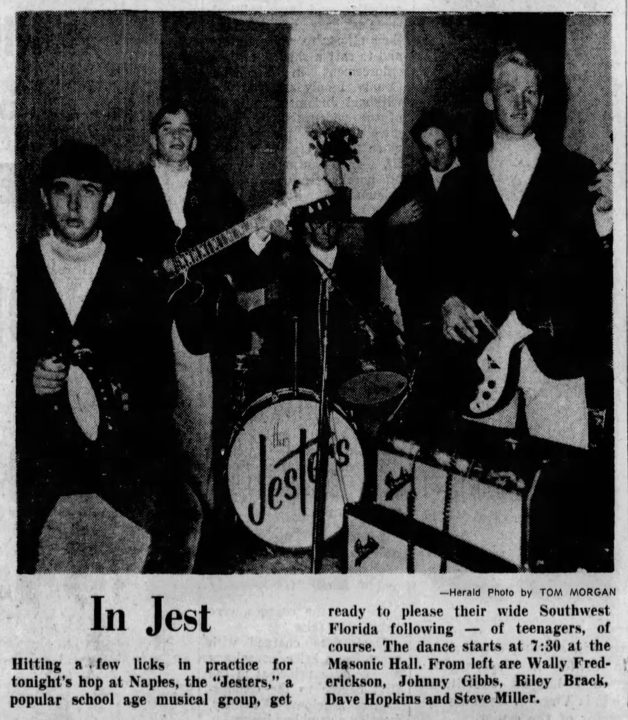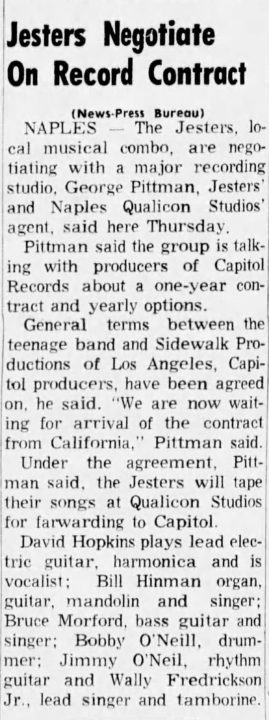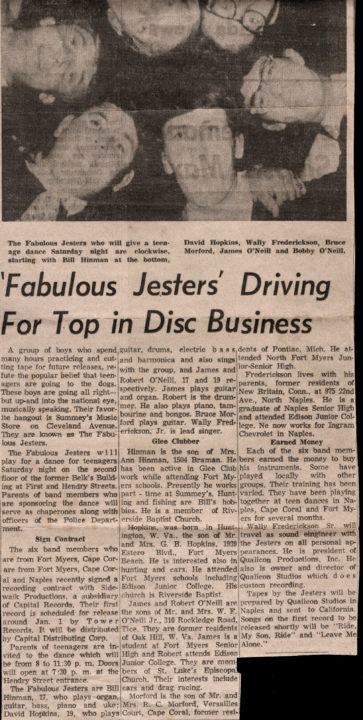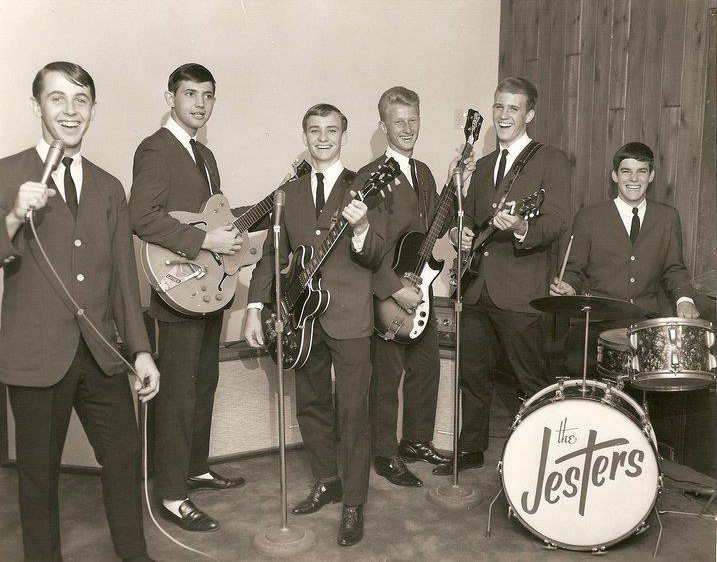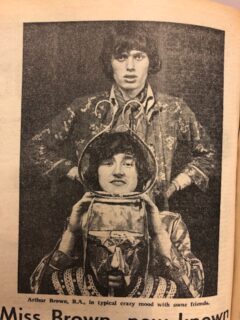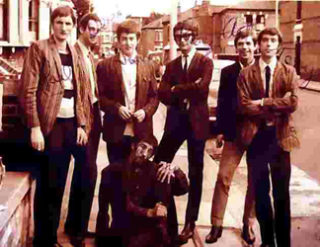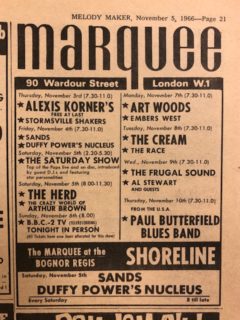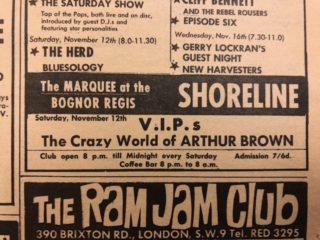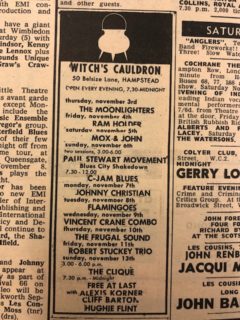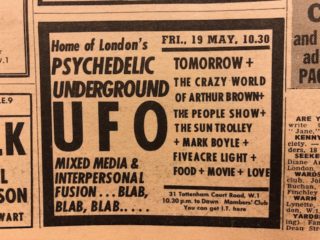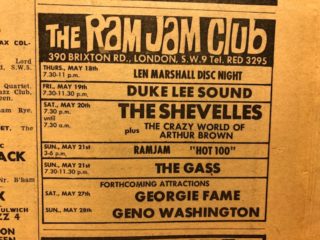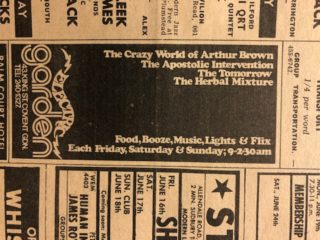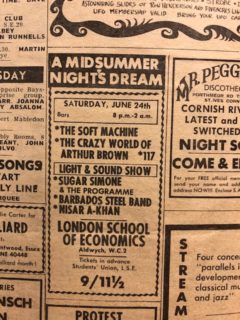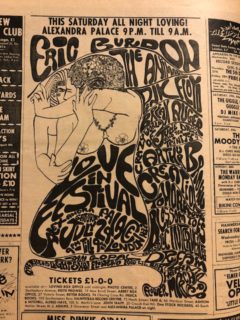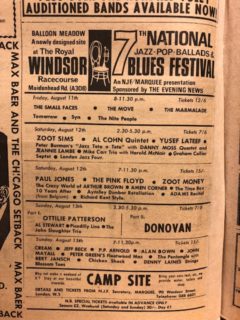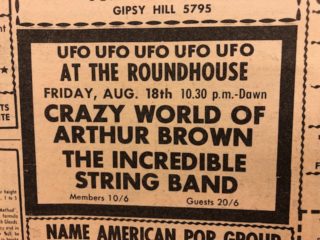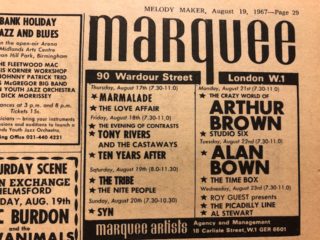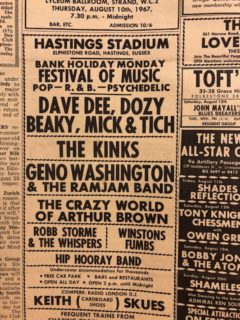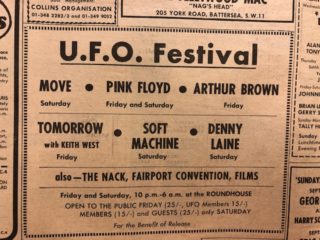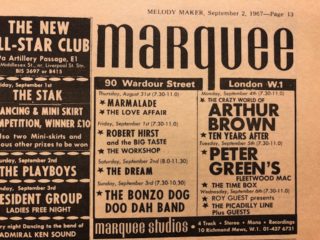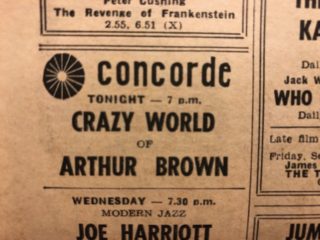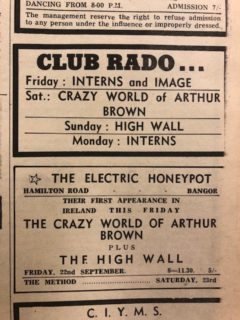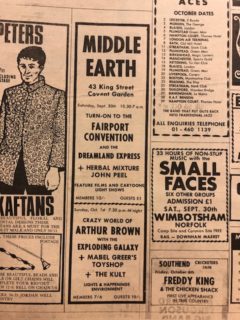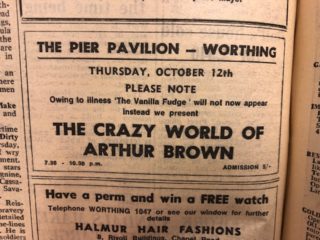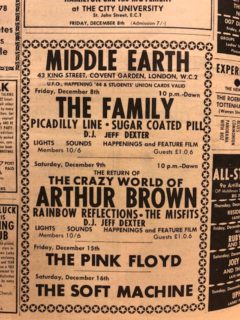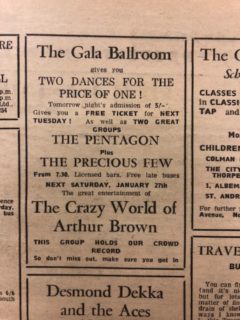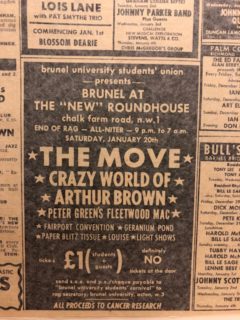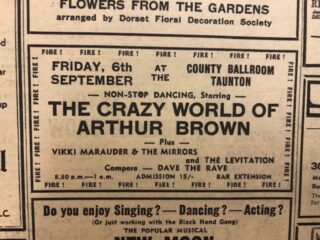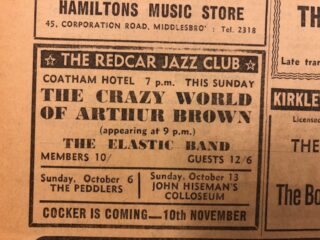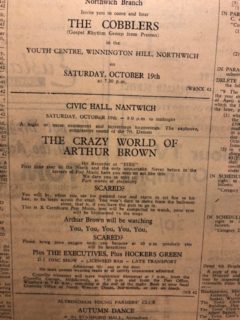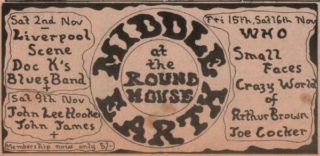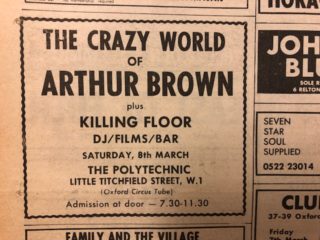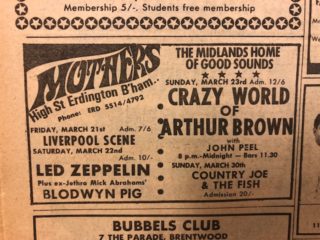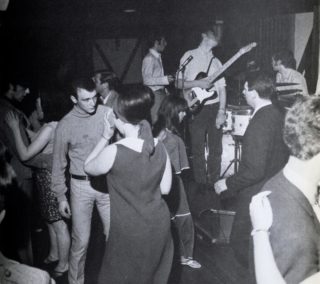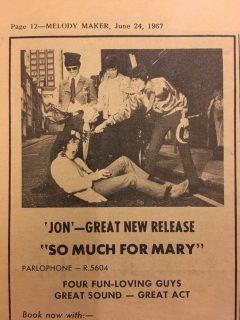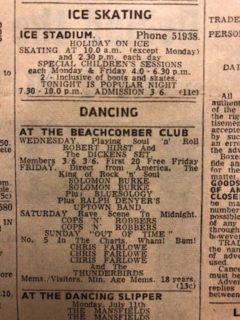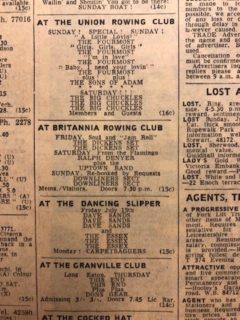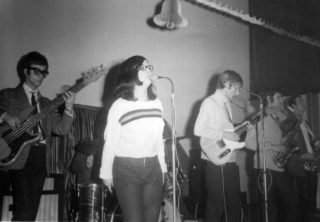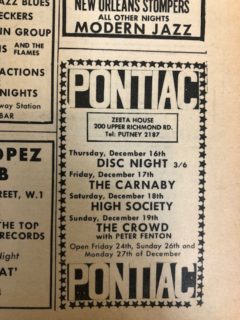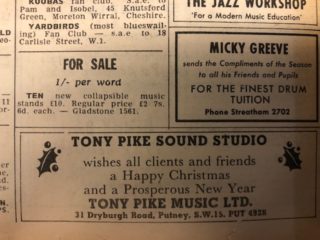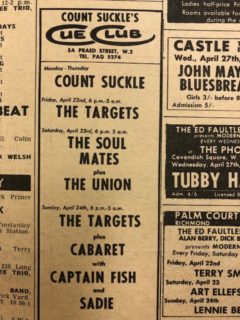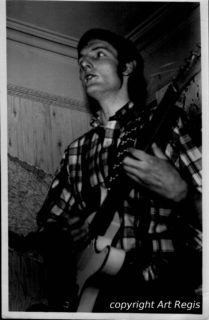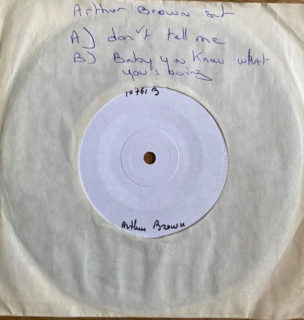One of the top rock clubs on the English south coast during the 1960s, the Club Continental in Eastbourne played host to many of the leading acts of the day. Among the future stars to appear on its stage was David Bowie.
I’ve started to put together a list of artists that played at the club below and would welcome any additions and memories in the comments section below.
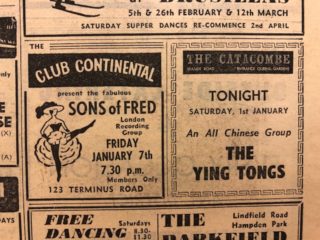
7 January 1966 (Friday) – Sons of Fred (Eastbourne Herald Chronicle)
14 January 1966 (Friday) – The Worrying Kynde (Eastbourne Herald Chronicle)
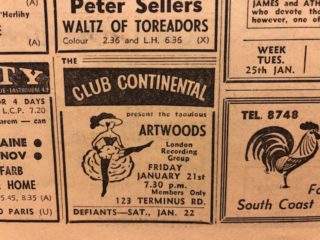
21 January 1966 (Friday) – The Artwoods (Eastbourne Herald Chronicle)
28 January 1966 (Friday) – Alexanders 4-Bidden, The Bootleggers, Breed, Nocturnal, System (Eastbourne Herald Chronicle)
2 February 1966 (Wednesday) – 4-Bidden (Eastbourne Herald Chronicle)
4 February 1966 (Friday) – Changing Times (Eastbourne Herald Chronicle)
5 February 1966 (Saturday) – Breed (Eastbourne Herald Chronicle)
6 February 1966 (Sunday) – Johnny Fine & The Ramblers (Eastbourne Herald Chronicle)
9 February 1966 (Wednesday) – System (Eastbourne Herald Chronicle)

11 February 1966 (Friday) – Plain and Fancy (Eastbourne Herald Chronicle)
12 February 1966 (Saturday) – The Aces (Eastbourne Herald Chronicle)
16 February 1966 (Wednesday) – Bootleggers (Eastbourne Herald Chronicle)
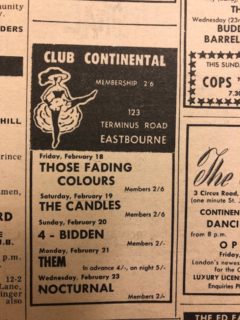
18 February 1966 (Friday) – Those Fading Colours (Eastbourne Herald Chronicle/Melody Maker) Formerly The King Pins
19 February 1966 (Saturday) – The Candles (Eastbourne Herald Chronicle/Melody Maker)
20 February 1966 (Sunday) – 4-Bidden (Melody Maker)
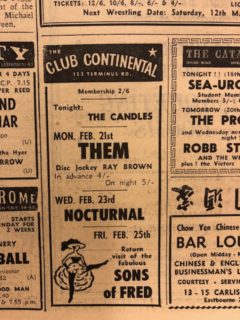
21 February 1966 (Monday) – Them (Eastbourne Herald Chronicle/Melody Maker) This is the Van Morrison version
23 February 1966 (Wednesday) – Nocturnal (Eastbourne Herald Chronicle/Melody Maker)
25 February 1966 (Friday) – Sons of Fred (Eastbourne Herald Chronicle)
26 February 1966 (Saturday) – Plain & Fancy (Eastbourne Herald Chronicle)
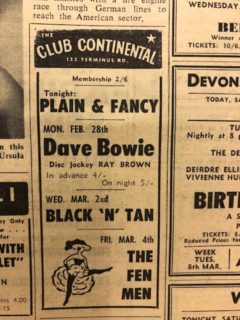
28 February 1966 (Monday) – David Bowie (& The Lower Third) (Eastbourne Herald Chronicle)
2 March 1966 (Wednesday) – Black ‘N’ Tan (Eastbourne Herald Chronicle)
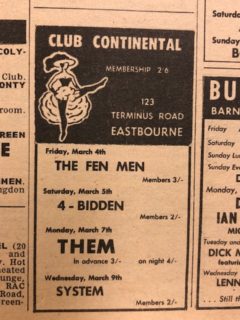
4 March 1966 (Friday) – The Fenmen (Eastbourne Herald Chronicle/Melody Maker)
5 March 1966 (Saturday) – 4-Bidden (Eastbourne Herald Chronicle/Melody Maker)
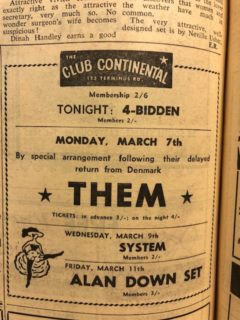
7 March 1966 (Monday) – Them (Eastbourne Herald Chronicle/Melody Maker) This is the rival Them with the McAuley brothers
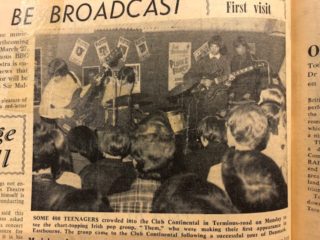
9 March 1966 (Wednesday) – System (Eastbourne Herald Chronicle/Melody Maker)
11 March 1966 (Friday) – Alan Down Set (Eastbourne Herald Chronicle) This is probably The Alan Bown Set
12 March 1966 (Saturday) – The Web (Eastbourne Herald Chronicle)
16 March 1966 (Wednesday) – Earl Richmond and The Confederates (Eastbourne Herald Chronicle)
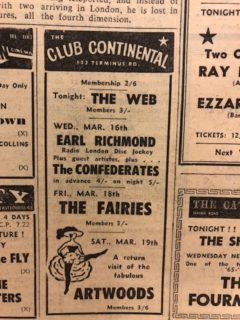
18 March 1966 (Friday) – The Fairies (Eastbourne Herald Chronicle)
19 March 1966 (Saturday) – The Artwoods (Eastbourne Herald Chronicle/Melody Maker)
21 March 1966 (Monday) – The Untamed (Eastbourne Herald Chronicle)
23 March 1966 (Wednesday) – Sons of Fred, The Majority and Lovin’ Kind (Eastbourne Herald Chronicle)
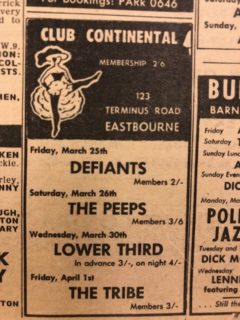
25 March 1966 (Friday) – Defiants (Eastbourne Herald Chronicle/Melody Maker)
26 March 1966 (Saturday) – The Peeps (Eastbourne Herald Chronicle/Melody Make)
30 March 1966 (Wednesday) – The Lower Third (Eastbourne Herald Chronicle/Melody Maker) David Bowie’s band
1 April 1966 (Friday) – The Tribe (Melody Maker)
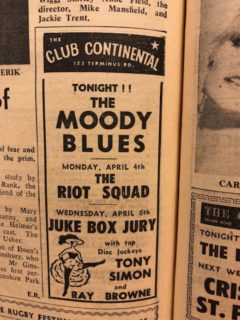
2 April 1966 (Saturday) – The Moody Blues (Eastbourne Herald Chronicle)
4 April 1966 (Monday) – The Riot Squad (Eastbourne Herald Chronicle)
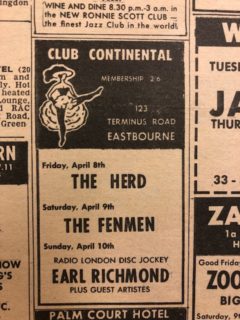
8 April 1966 (Friday) – The Herd (Melody Maker)
9 April 1966 (Saturday) – The Fenmen (Eastbourne Herald Chronicle/Melody Maker)
10 April 1966 (Sunday) – Earl Richmond and Guest Artistes (Eastbourne Herald Chronicle)
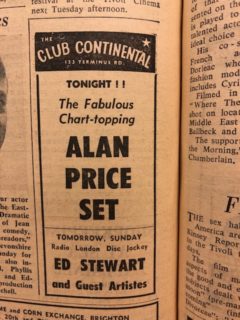
16 April 1966 (Saturday) – The Alan Price Set (Eastbourne Herald Chronicle)
23 April 1966 (Saturday) – HT and The Rockbeats (Eastbourne Herald Chronicle)
24 April 1966 (Sunday) – The Roman Empire Show (Eastbourne Herald Chronicle)
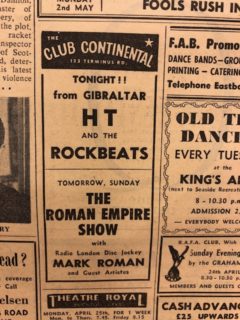
30 April 1966 (Saturday) – 4-Bidden (Eastbourne Herald Chronicle)
1 May 1966 (Sunday) – Earl Richmond with guest artistes (Eastbourne Herald Chronicle)
4 May 1966 (Wednesday) – The Untamed (Eastbourne Herald Chronicle)
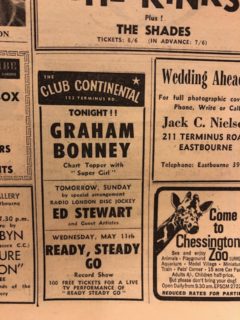
7 May 1966 (Saturday) – Graham Bonney (Eastbourne Herald Chronicle)
8 May 1966 (Sunday) – Ed Stewart (Eastbourne Herald Chronicle)
14 May 1966 (Saturday) – Emeralds (Eastbourne Herald Chronicle)
15 May 1966 (Sunday) – Earl Richmond (Eastbourne Herald Chronicle)
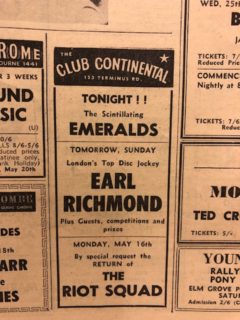
16 May 1966 (Monday) – The Riot Squad (Eastbourne Herald Chronicle)
21 May 1966 (Saturday) – Dave Berry & The Cruisers (Eastbourne Herald Chronicle)
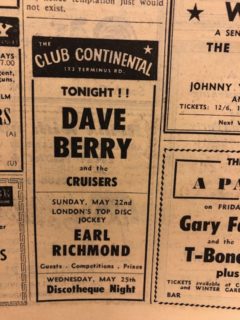
22 May 1966 (Sunday) – Earl Richmond (Eastbourne Herald Chronicle)
27 May 1966 (Friday) – Gary Farr & The T-Bones, David and Jonathan and The 4-Bidden (Eastbourne Herald Chronicle) This is held at the Winter Garden. The 4-Bidden changed name to St John’s Wood in 1967.
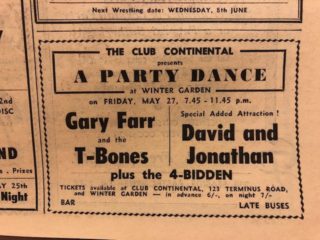
28 May 1966 (Saturday) – Pete Budd & The Rebels (Eastbourne Herald Chronicle)
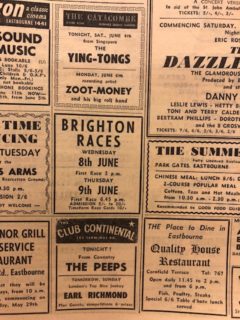
4 June 1966 (Saturday) – The Peeps (Eastbourne Herald Chronicle)
5 June 1966 (Sunday) – Earl Richmond (Eastbourne Herald Chronicle)
11 June 1966 (Saturday) – HT & The Rockbeats (Eastbourne Herald Chronicle)
18 June 1966 (Saturday) – The Four Pennies (Eastbourne Herald Chronicle)

25 June 1966 (Saturday) – Sons of Fred (Eastbourne Herald Chronicle)
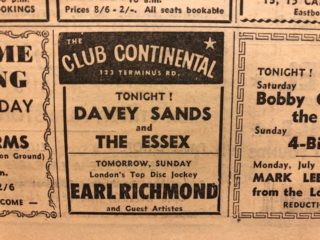
2 July 1966 (Saturday) – Davey Sands & The Essex (Eastbourne Herald Chronicle)
3 July 1966 (Sunday) – Earl Richmond (Eastbourne Herald Chronicle)
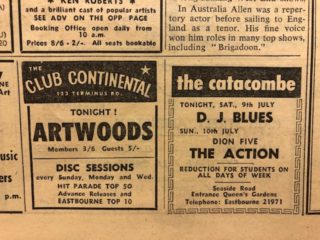
9 July 1966 (Saturday) – The Artwoods (Eastbourne Herald Chronicle/Fabulous 208)
16 July 1966 (Saturday) – Zoot Money & The Big Roll Band (Beat Instrumental/Eastbourne Herald Chronicle)
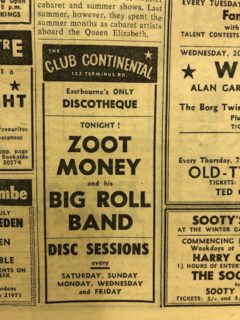
23 July 1966 (Saturday) – Those Fading Colours (Eastbourne Herald Chronicle)
29 July 1966 (Friday) – The Fenmen (Eastbourne Herald Chronicle)
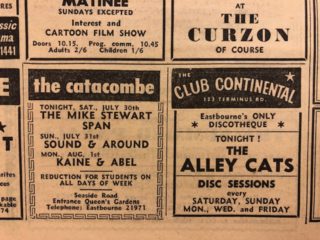
30 July 1966 (Saturday) – The Alley Cats (Eastbourne Herald Chronicle)
6 August 1966 (Saturday) – The Coloured Raisins (Eastbourne Herald Chronicle)
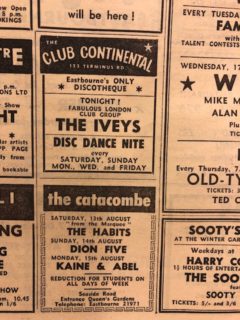
13 August 1966 (Saturday) – The Iveys (Eastbourne Herald Chronicle)
20 August 1966 (Saturday) – The Candy Dates (Eastbourne Herald Chronicle)
27 August 1966 (Saturday) – The HT (Eastbourne Herald Chronicle)
2 September 1966 (Friday) – The Artwoods (Fabulous 208)
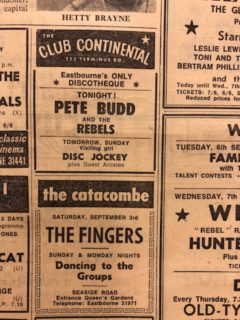
3 September 1966 (Saturday) – Pete Budd & The Rebels (Eastbourne Herald Chronicle)
10 September 1966 (Saturday) – The Breed (Eastbourne Herald Chronicle)
17 September 1966 (Saturday) – Fading Colours (Eastbourne Herald Chronicle)

24 September 1966 (Saturday) – Helen Brailey (Eastbourne Herald Chronicle)
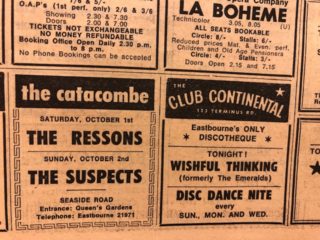
1 October 1966 (Saturday) – Wishful Thinking (Eastbourne Herald Chronicle) Formerly The Emeralds
8 October 1966 (Saturday) – Boy’s Blue (Eastbourne Herald Chronicle)
15 October 1966 (Saturday) – The End (Eastbourne Herald Chronicle) This may not be the Surrey band that worked with Bill Wyman but a local group instead
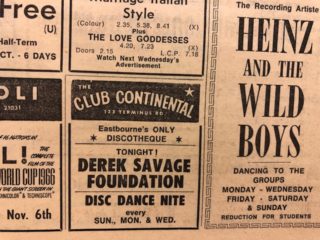
22 October 1966 (Saturday) – Derek Savage Foundation (Eastbourne Herald Chronicle)
29 October 1966 (Saturday) – Those Fadin’ Colours (Eastbourne Herald Chronicle)
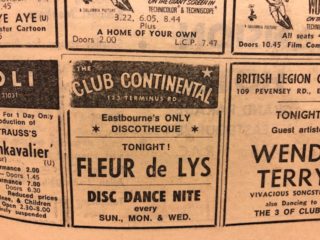
5 November 1966 (Saturday) – The Fleur De Lys (Eastbourne Herald Chronicle)
12 November 1966 (Saturday) – The End (Eastbourne Herald Chronicle) This may not be the Surrey band that worked with Bill Wyman but a local group instead
19 November 1966 (Saturday) – The Fading Colours (Eastbourne Herald Chronicle)
25 November 1966 (Friday) – The Artwoods (Fabulous 208)

26 November 1966 (Saturday) – Winston G (Eastbourne Herald Chronicle)
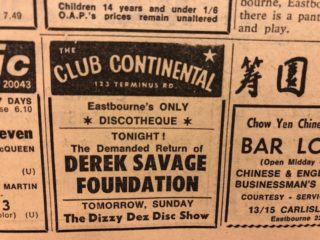
3 December 1966 (Saturday) – Derek Savage Foundation (Eastbourne Herald Chronicle)
10 December 1966 (Saturday) – The Goodthings (Eastbourne Herald Chronicle)
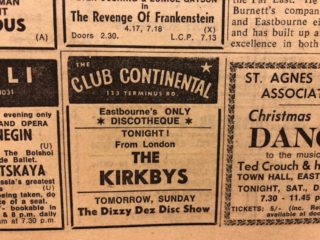
17 December 1966 (Saturday) – The Kirkbys (Eastbourne Herald Chronicle)
7 January 1967 (Saturday) – The Sean Buckley Set (Eastbourne Herald Chronicle)
14 January 1967 (Saturday) – Winston G (Eastbourne Herald Chronicle)
21 January 1967 (Saturday) – The Variations (Eastbourne Herald Chronicle)
28 January 1967 (Saturday) – The Breeds Blue Band (Eastbourne Herald Chronicle)
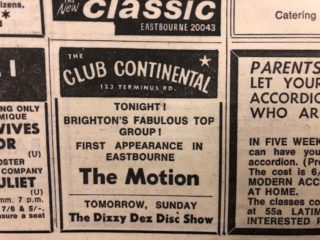
4 February1967 (Saturday) – The Motion (Eastbourne Herald Chronicle)

11 February 1967 (Saturday) – The Derek Savage Foundation (Eastbourne Herald Chronicle)

18 February 1967 (Saturday) – The Five Proud Walkers (Eastbourne Herald Chronicle)
25 February 1967 (Saturday) – The Coloured Raisins (Eastbourne Herald Chronicle)
5 March 1967 (Saturday) – Missing entry
11 March 1967 (Saturday) – The Farm Band (Eastbourne Herald Chronicle)
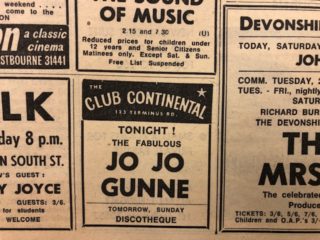
18 March 1967 (Saturday) – Jo Jo Gunne (Eastbourne Herald Chronicle)
25 March 1967 (Saturday) – The Fadin’ Colours (Eastbourne Herald Chronicle)
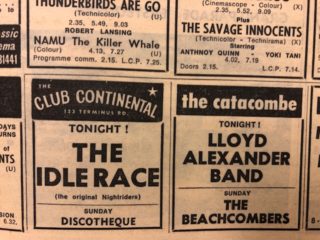
1 April 1967 (Saturday) – The Idle Race (Eastbourne Herald Chronicle)
8 April 1967 (Saturday) – The Mad’ing Crowd (Eastbourne Herald Chronicle)
15 April 1967 (Saturday) – The Human Instinct (Eastbourne Herald Chronicle)
22 April 1967 (Saturday) – The Ourselves (Eastbourne Herald Chronicle)
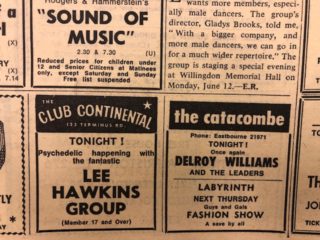
29 April 1967 (Saturday) – The Lee Hawkins Group (Eastbourne Herald Chronicle)
6 May 1967 (Saturday) – The Odds On (Eastbourne Herald Chronicle)
13 May 1967 (Saturday) – The Hush (Eastbourne Herald Chronicle)
20 May 1967 (Saturday) – The Lee Hawkins Group (Eastbourne Herald Chronicle)
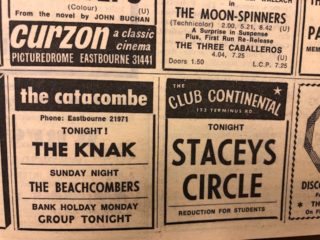
27 May 1967 (Saturday) – Stacey’s Circle (Eastbourne Herald Chronicle)
3 June 1967 (Saturday) – Missing entry
10 June 1967 (Saturday) – Disco
17 June 1967 (Saturday) – Disco
24 June 1967 (Saturday) – Soul supply show
1 July 1967 (Saturday) – Disco
8 July 1967 (Saturday) – Disco
15 July 1967 (Saturday) – Disco
22 July 1967 (Saturday) – Disco
29 July 1967 (Saturday) – The Earl Dee Group, The Target and Soul Supply Show (Eastbourne Herald Chronicle)
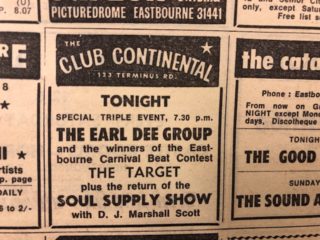
5 August 1967 (Saturday) – Urchins (Eastbourne Herald Chronicle)
12 August 1967 (Saturday) – Dr Marigold’s Prescription (Eastbourne Herald Chronicle)
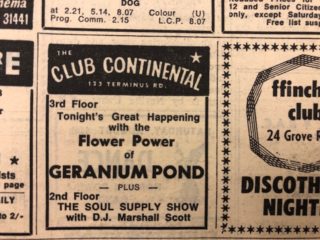
19 August 1967 (Saturday) – Geranium Pond (Eastbourne Herald Chronicle)
26 August 1967 (Saturday) – Soul supply show
2 September 1967 (Saturday) – The Lee Hawkins Group (Eastbourne Herald Chronicle)
9 September 1967 (Saturday) – 100 Watt Carnation (Eastbourne Herald Chronicle)
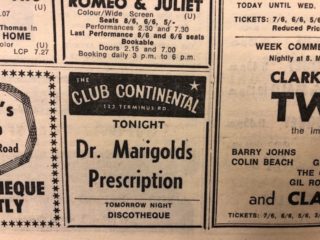
16 September 1967 (Saturday) – Dr Marigold’s Prescription (Eastbourne Herald Chronicle)
23 September 1967 (Saturday) – Mr Hip Soul Band (Eastbourne Herald Chronicle)
29 September 1967 (Friday) – The Coloured Raisins (Eastbourne Herald Chronicle)
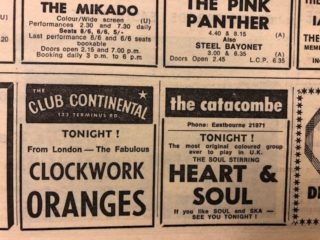
30 September 1967 (Saturday) – The Clockwork Oranges (Eastbourne Herald Chronicle)
7 October 1967 (Saturday) – Eddie Singh and West Indian Tornados (Eastbourne Herald Chronicle)
14 October 1967 (Saturday) – Sunset Sound (Eastbourne Herald Chronicle)
21 October 1967 (Saturday) – The Fabulous Collection (Eastbourne Herald Chronicle)
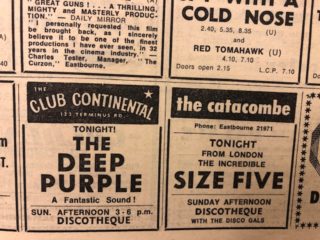
28 October 1967 (Saturday) – Deep Purple (Eastbourne Herald Chronicle) This might be the version formed by Mick Wheeler after he left The All Night Workers and before joining Jo Jo Gunne but needs confirmation
4 November 1967 (Saturday) – The Living Daylights (Eastbourne Herald Chronicle)
11 November 1967 (Saturday) – Disco
18 November 1967 (Saturday) – Disco
25 November 1967 (Saturday) – Disco
2 December 1967 (Saturday) – Disco
9 December 1967 (Saturday) – Missing
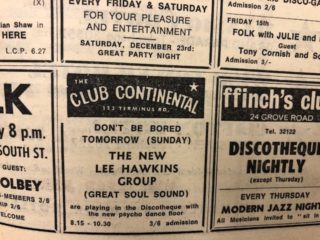
10 December 1967 (Sunday) – The New Lee Hawkins Group (Eastbourne Herald Chronicle)
16 December 1967 (Saturday) – Missing
23 December 1967 (Saturday) – The Coloured Raisins (Eastbourne Herald Chronicle)
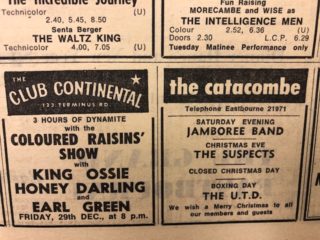
29 December 1967 (Friday) – The Coloured Raisins with King Ossie, Honey Darling and Earl Green (Eastbourne Herald Chronicle)
30 December 1967 (Saturday) – Missing
Copyright © Nick Warburton. All Rights Reserved. No part of this article may be reproduced or transmitted in any from or by any means, without prior permission from the author.

